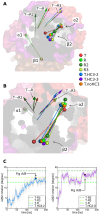Spontaneous quaternary and tertiary T-R transitions of human hemoglobin in molecular dynamics simulation
- PMID: 20463873
- PMCID: PMC2865513
- DOI: 10.1371/journal.pcbi.1000774
Spontaneous quaternary and tertiary T-R transitions of human hemoglobin in molecular dynamics simulation
Abstract
We present molecular dynamics simulations of unliganded human hemoglobin (Hb) A under physiological conditions, starting from the R, R2, and T state. The simulations were carried out with protonated and deprotonated HC3 histidines His(beta)146, and they sum up to a total length of 5.6 micros. We observe spontaneous and reproducible T-->R quaternary transitions of the Hb tetramer and tertiary transitions of the alpha and beta subunits, as detected from principal component projections, from an RMSD measure, and from rigid body rotation analysis. The simulations reveal a marked asymmetry between the alpha and beta subunits. Using the mutual information as correlation measure, we find that the beta subunits are substantially more strongly linked to the quaternary transition than the alpha subunits. In addition, the tertiary populations of the alpha and beta subunits differ substantially, with the beta subunits showing a tendency towards R, and the alpha subunits showing a tendency towards T. Based on the simulation results, we present a transition pathway for coupled quaternary and tertiary transitions between the R and T conformations of Hb.
Conflict of interest statement
The authors have declared that no competing interests exist.
Figures








Similar articles
-
Quaternary-Linked Changes in Structure and Dynamics That Modulate O2 Migration within Hemoglobin's Gas Diffusion Tunnels.Biochemistry. 2015 Sep 1;54(34):5268-78. doi: 10.1021/acs.biochem.5b00368. Epub 2015 Aug 19. Biochemistry. 2015. PMID: 26226318
-
The 1.9 A structure of deoxy beta 4 hemoglobin. Analysis of the partitioning of quaternary-associated and ligand-induced changes in tertiary structure.J Mol Biol. 1994 Feb 25;236(3):831-43. doi: 10.1006/jmbi.1994.1192. J Mol Biol. 1994. PMID: 8114097
-
Crystallographic analysis of the interaction of nitric oxide with quaternary-T human hemoglobin.Biochemistry. 2004 Jan 13;43(1):118-32. doi: 10.1021/bi030172j. Biochemistry. 2004. PMID: 14705937
-
Evolution of allosteric models for hemoglobin.IUBMB Life. 2007 Aug-Sep;59(8-9):586-99. doi: 10.1080/15216540701272380. IUBMB Life. 2007. PMID: 17701554 Review.
-
The functional role of the hemoglobin-water interface.Mol Aspects Med. 2022 Apr;84:101042. doi: 10.1016/j.mam.2021.101042. Epub 2021 Oct 29. Mol Aspects Med. 2022. PMID: 34756740 Review.
Cited by
-
Evaluating sheep hemoglobins with MD simulations as an animal model for sickle cell disease.Sci Rep. 2024 Jan 2;14(1):276. doi: 10.1038/s41598-023-50707-y. Sci Rep. 2024. PMID: 38168584 Free PMC article.
-
Non-site-specific allosteric effect of oxygen on human hemoglobin under high oxygen partial pressure.Sci Rep. 2014 Apr 8;4:4601. doi: 10.1038/srep04601. Sci Rep. 2014. PMID: 24710521 Free PMC article.
-
Ligand and interfacial dynamics in a homodimeric hemoglobin.Struct Dyn. 2016 Feb 17;3(1):012003. doi: 10.1063/1.4940228. eCollection 2016 Jan. Struct Dyn. 2016. PMID: 26958581 Free PMC article.
-
It is rocket science - why dietary nitrate is hard to 'beet'! Part I: twists and turns in the realization of the nitrate-nitrite-NO pathway.Br J Clin Pharmacol. 2017 Jan;83(1):129-139. doi: 10.1111/bcp.12913. Epub 2016 May 6. Br J Clin Pharmacol. 2017. PMID: 26896747 Free PMC article. Review.
-
Dynamics of camel and human hemoglobin revealed by molecular simulations.Sci Rep. 2022 Jan 7;12(1):122. doi: 10.1038/s41598-021-04112-y. Sci Rep. 2022. PMID: 34997093 Free PMC article.
References
-
- Perutz MF, Wilkinson AJ, Paoli M, Dodson GG. The stereochemical mechanism of the cooperative effects in hemoglobin revisited. Annu Rev Biophys Biomol Struct. 1998;27:1–34. - PubMed
-
- Eaton WA, Henry ER, Hofrichter J, Bettati S, Viappiani C, et al. Evolution of allosteric models for hemoglobin. IUBMB Life. 2007;59:586–599. - PubMed
-
- Perutz MF. Stereochemistry of cooperative effects in haemoglobin. Nature. 1970;228:726–739. - PubMed
-
- Monod J, Wyman J, Changeux J-P. On the nature of Allosteric Transitions: A Plausible Model. J Mol Biol. 1965;12:88–118. - PubMed
-
- Shih T, Jones RT, Bonaventura J, Bonaventura C, Schneider RG. Involvement of His HC3 (146) beta in the Bohr effect of human hemoglobin. Studies of native and N-ethylmaleimide-treated hemoglobin A and hemoglobin Cowtown (beta 146 His replaced by Leu). J Biol Chem. 1984;259:967–974. - PubMed
Publication types
MeSH terms
Substances
LinkOut - more resources
Full Text Sources

